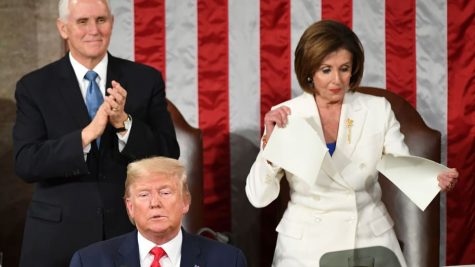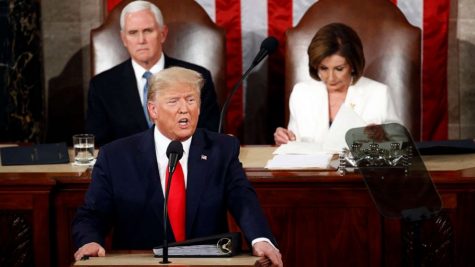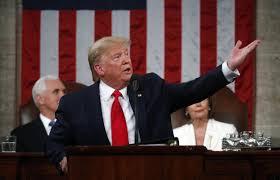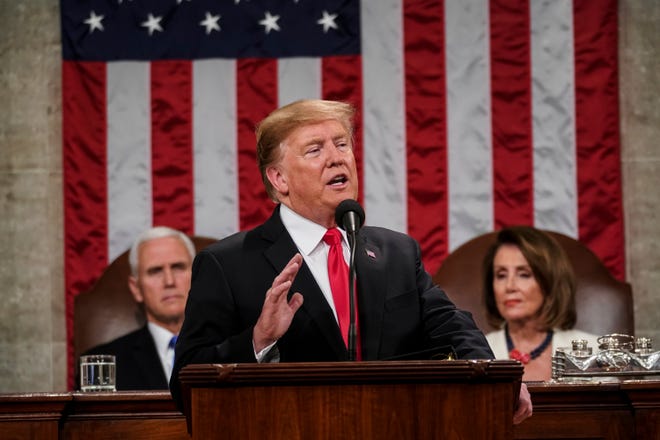Addressing the Address
Going Over Donald Trump’s 2020 State of the Union Address
March 4, 2020
On Tuesday February 4, President Donald Trump gave the annual State of the Union address to Congress. This was a day before the Senate cast its votes in the impeachment trial, which was not mentioned during this speech.
The address began with President Trump refusing to shake Nancy Pelosi’s hand, as per tradition, leading to Pelosi tearing her copy of the speech in half at the end of the president’s speech, reportedly because many parts of the speech were factually incorrect (CNN). She stayed silent and still whenever the president said something garnering applause that she did not agree with, which was often.

President Trump started his speech by calling the time he was in office the “great American comeback.” He said America’s economy is at the highest point in history, and that he has created seven million new jobs since his election in 2016. This includes higher employment rates for women, people of color, veterans, and disabled citizens. While most of this is true, the points that he made are made less impressive when looking at how long the U.S. government has been tracking these statistics. For example, unemployment rates for people with disabilities has only been tracked since 2008, so there is no way to know for sure just how accurate this information is.
Food stamps were mentioned after the employment rates, with President Trump saying he and his administration were able to get seven million people off of food stamps, and ten million people off of welfare. The number for food stamps is exaggerated by over one million. In fact, if including data from North Carolina, which was excluded, “the decline was closer to 5 million” (CNN). This drop in numbers is also partly because people are no longer allowed to be on food stamps, rather than them being economically stable enough to do so (NBC). President Trump then moves on to the stock market, claiming they have “soared 70%, adding more than twelve trillion dollars to our nation’s wealth.”
Then it was time for the discussion of natural gas and oil, of which the U.S. has become the largest producer of under Trump’s administration. This is mostly true, except this growth happened under Obama. According to the U.S. Energy Information Administration, the U.S. “has been the world’s top producer of natural gas since 2009, when U.S. natural gas production surpassed that of Russia, and it has been the world’s top producer of petroleum hydrocarbons since 2013, when its production exceeded Saudi Arabia’s.”
President Trump went on, explaining that around sixty thousand factories were lost under the last two administrations. However, under his administration America has reportedly created about twelve thousand new factories. In addition to these, there are also thousands of factories and plants being built or planned.
The president touched on the topic of trade deals after factories, and talked about the replacement of NAFTA, or the North American Free Trade Agreement, which helped create fair trade between the United States, Canada, and Mexico. This is “perhaps the biggest reason” Trump wanted to become president. He put the U.S.M.C.A., or U.S.-Mexico-Canada Agreement, into place less than a week before his speech. Trump said this will create almost one hundred thousand new auto jobs for Americans, which is inflated. In fact, the Trump Administration itself put out statistics, reporting that the number would be up to seventy six thousand over the next five years. These discussions of trade also brought up tariffs, and how President Trump imposed tariffs to “confront China’s massive theft of American’s jobs.”

Next was the military. According to Trump, around $2.2 trillion have been invested into the U.S. military. A portion of this money went into creating the new branch: the Space Force. Planning for this new military branch began on June 2018, and was established on December 20, 2019 (United States Space Force).
Then after the military it was time to talk about education. With a brief mention of the Education Freedom Scholarships and Opportunities Act, a law trying to pass that gives some lower class kids scholarships to the school of their choice that better fits their needs, President Trumps moves on to talk about his wife and her “Be Best” initiative. This campaign focuses on children, and how people should work harder against cyberbullying and drug use to protect said children (White House).
Trump moved on to healthcare, saying that, in five years, healthcare premiums had more than doubled before he took office. He went on, saying he will “always protect patients with preexisting [sic] conditions,” and said he had signed an executive order guaranteeing price transparency to avoid American patients being “blindsided by medical bills.”
After healthcare was the discussion of immigration. President Trump stood strongly against allowing free health care go to apply to illegal immigrants, then quickly began talking about his wall. There are over 100 miles of the wall built, and Trump’s administration estimates over 500 miles will be completed “early next year.”
The topic quickly changed to pharmaceutical drugs. According to President Trump, the cost of prescription drugs has gone down for the first time in 51 years. This timeline is not quite accurate, as the price dropped 0.6% in December 2018, which was the largest decrease since 1971. This is not the first drop, nor is it a length of 51 years.

Somewhat related is the decline of overdose deaths in many states. Ohio’s amount of deaths by drug overdoses went down by 22%, Pennsylvania by 18%, and Wisconsin by 10%. This is a large number of people, and something Trump has been talking about for many years.
Trump is also trying to fix the issue of Coronavirus, also known as COVID-19, and other diseases like Alzheimer’s that are being discussed by world leaders. President Trump assured citizens that his administration “will take all necessary steps to safeguard our citizens from this threat.” He also promised that the AIDs epidemic will be entirely wiped out and childhood cancer will have a cure by the end of the decade.
Then there was a shift to infants and childbirth. President Trump said half of premature babies born, at least at one unnamed hospital, now survive. This turns into President Trump’s stance on abortion, informing those present that he wanted Congress to ban late-term abortion.
Trump transitioned to speaking of the importance of the environment, and how the United States will soon join the One Trillion Trees Initiative. This effort is to try bringing communities together to plant trees all around the world. Once finished with this, President Trump started talking about America’s need for new highways and better infrastructure.
President Trump then shifted to the topic of ICE, calling them heroes and explaining how ICE has arrested over 120,000 illegal immigrants. He went on, talking about how many American cities provide aid to these “criminal illegal aliens.” Police in these sanctuary cities were ordered by “local officials” to let immigrants go, rather than allow ICE to remove them from the country. The entire state of California was declared a sanctuary state, leading to a legislation allowing people to sue sanctuary states and cities when they or a loved when is injured or killed due to immigrants being released.
The practice of “catch and release,” as said by Trump, has been ended by his administration. This refers to previous offices allowing people who illegally crossed the border to remain in the U.S. and not show up to their assigned court date. Data from the Department of Justice, however, has shown that around 90% of those seeking asylum did show up for their court hearings as of 2017. Crossing into the U.S. illegally in the first place was said to have dropped by 75 percent, which is true, though May had the largest number of illegal crossing throughout his presidency, and the number of people crossing the border illegally has increased since Trump became president.
Donald Trump ended his speech talking about the “American age” and calling the American people pioneers. He assured the audience that the best is yet to come, before thanking everyone and ending his State of the Union Address of 2020.



